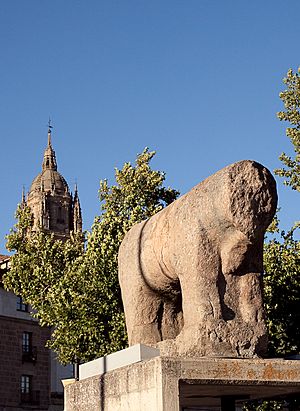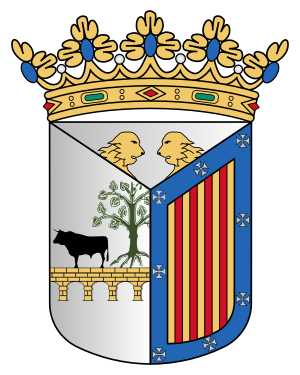Verraco of the bridge facts for kids

Verraco of the bridge with the cathedral of Salamanca behind
|
|
| Alternative name | Bull of the bridge |
|---|---|
| Location | Salamanca, Spain |
| Coordinates | 40°57′33″N 5°40′09″W / 40.95917°N 5.66917°W |
| History | |
| Material | stone |
| Founded | 3rd–1st century BC |
| Periods | Iron Age |
| Cultures | Vettones |
The Verraco of the bridge is a very old stone statue in Salamanca, Spain. It looks like a bull and stands at the entrance of the Roman bridge. People often call it the "bull of Salamanca" or the "bull of the bridge."
A Verraco is a special type of stone animal statue. Ancient people called the Vettones made these statues during the Iron Age. The word verraco in Spanish means "breeding pig," but these statues could also be bulls, bears, or other animals.
This bull statue is the oldest one in Salamanca. It even appears on the city's coat of arms! The statue is about 2.10 meters (almost 7 feet) long, 1.57 meters (about 5 feet) tall, and 70 centimeters (about 2.3 feet) wide. Its head is missing, and its body was once broken in half, but it has been put back together.
What is the History of the Verraco?
The Vettones tribes created verracos a very long time ago, during the late Iron Age. They placed these statues in different spots across the central plains of the Iberian peninsula. The bull statue in Salamanca has been near the Roman bridge since the late 1100s. Old writings and stories mention it being there.
Why Was the Verraco Thrown into the River?
In 1834, a governor named José María Cambronero ordered the verraco to be thrown into the Tormes river. He thought King Charles I of Spain had put it there because of a rebellion called the Revolt of the Comuneros. Salamanca had taken part in this rebellion. When the statue was thrown, it broke into three pieces.
How Was the Verraco Rescued and Moved?
Luckily, in 1867, the statue was saved from the river. It was first moved to the Convento de San Esteban (a monastery). After that, it traveled to different museums. Finally, in 1954, it was brought back to the Roman bridge. This was a special year because it was the 400th anniversary of a famous book called Lazarillo de Tormes, which mentions the bull.
The statue was first placed in the middle of the bridge. But since 1993, it has stood at the entrance of the bridge. Over the years, the statue has had some minor damage from people, like in 2016 and 2019.
 In Spanish: Verraco del puente (Salamanca) para niños
In Spanish: Verraco del puente (Salamanca) para niños



